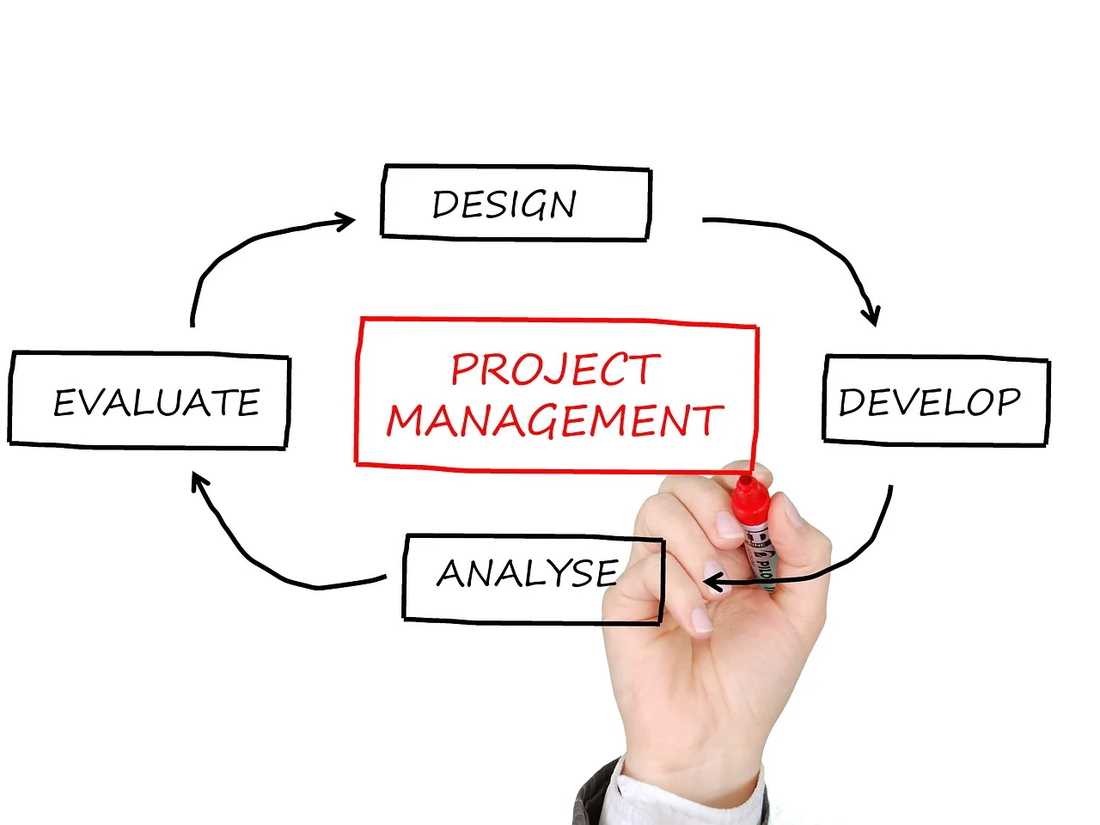
Software Project Plan – How to Develop an Idea
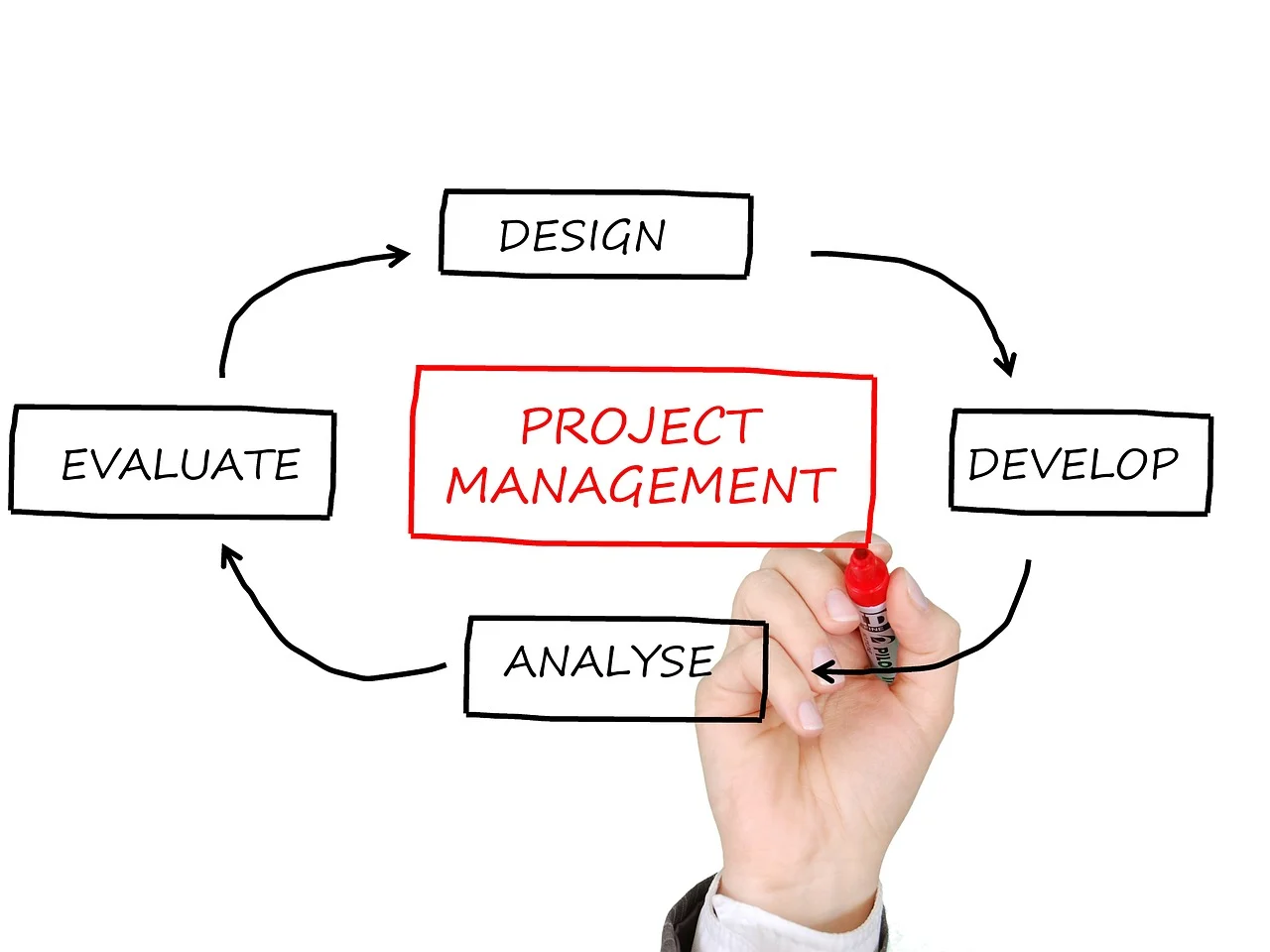
When starting a new project, it is crucial to craft an effective plan. This step is instrumental in formulating a sound strategy aligned with your desired objectives, assembling a competent development team, and proactively preparing for unforeseen circumstances. A software development project plan serves as the cornerstone of this process, representing a vital component within the realm of software development. It serves as an indispensable guide for project managers and stakeholders, outlining the necessary steps to ensure the project's success.
To manage such an endeavor, you need to have well-thought-out software development planning, as programs are getting increasingly advanced these days, and getting your software projects onto the market is a real challenge.
The primary objective of software project planning is to establish goals, methodologies, objectives, and team composition.
A robust project plan serves as both a roadmap for stakeholders and a means to anticipate and address potential issues during the planning phase. Having clear project goals can advance your project plan, and with suitable budgeting options and resource allocation, you can save up a lot of money.
In this article, we will go over all the details on how to create a project plan, what kind of project planning software would be the best for this particular concept, and what are some of the tips for creating a successful project plan. All that is with adding a software development plan template for you to utilize entirely for free. Let’s dive in!
Software Project Plan – How to Develop an Idea
What Is a Project Plan?
A project plan is a comprehensive spreadsheet that presents all the essential information about the project. Those would be the objectives, scope, deliverables, timelines, resources, and other activities necessary to complete a task.
It can also help create the right project timeline that you can always go back to when you want to set deadlines for example. Most detailed project plans aim to become a roadmap for all the stakeholders.
If done correctly, with all the project phases, risk management and project objectives, it can become a great tool for project coordination, managing resources, and becoming a reference point in the project development process. Here are some key elements that you can utilize for the software delivery.
Project Objectives
The first thing you need to do is to set clear project objectives. In this case, it’s all about being SMART – specific, measurable, achievable, relevant, and time-bound. Most software projects rely on setting the proper project milestones, so if you want to create a software development plan, you need to know exactly what you are trying to accomplish.
Project Scope
The next thing to consider is the project’s scope. Be sure to clearly define the project's boundaries, as the project deliverables are the priority in this case, and, especially software projects, can get quite complicated with time. With the proper scope, you can prevent the neverending workflow and keep the deadlines.
Deliverables
Precise identification of the desired project deliverables is crucial for a successful project conclusion. It is imperative to clearly define the software products intended for release and articulate the specific project components to be implemented in each software version. This level of precision ensures clarity and alignment among the project team, leading to a more effective and successful project outcome.
Deadlines
Be sure to include deadlines and an explicit schedule for the project's start and end. Of course, it can vary depending on the phases of the plan. It’s important, though, to have a clear timeline that you can use to know when you can demand deliverables. It can also help you track progress and synchronize different project parts.
Risk Management
An effective project data should encompass a robust risk management plan. It is crucial to anticipate potential issues that may arise during various production stages and develop contingency plans to address them. By identifying potential risks and establishing proactive mitigation strategies, the project team can better prepare for unforeseen circumstances.
Budget
The project budget part of the software project plan is a critical element in determining the costs associated with the project. Those would be everything from the stakeholders’ salaries, to all the materials you need to create software, computers, internet connection, etc. It’s the part that you should put a lot of emphasis on, as software development can get a bit pricey if not appropriately handled.
Resources
Speaking of budgeting – be sure that you have all the resources needed for the project to start. That would mean all the project’s stakeholders, design team, managers, and other participants. Getting the right people for the job is one of the most crucial success criteria that you can point to. Additionally, see if you need to upgrade your equipment to mitigate any technical risks you may face.
Evaluation
And finally - the evaluation. It will help you to create methods used to measure the project’s progress, see if the estimated costs are in line with what is happening in the company, and just overall – keep an eye on things. It’s a way of adjusting and improving the project’s execution and keeping track of project progress.
What Kind of Software Should You Use?
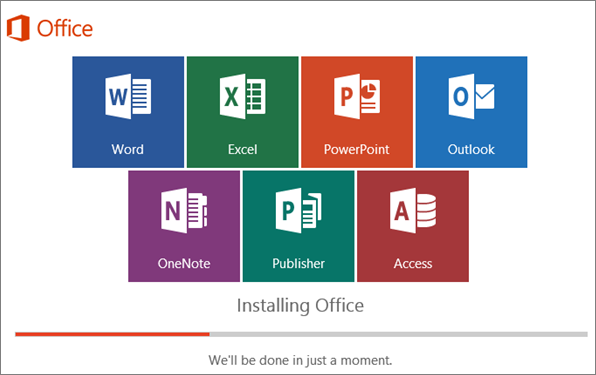
Now let’s go over the software that we will be using for our software project plan. In this case, we recommend getting Microsoft Office, a leading suite for all office purposes. To build software, you need powerful machinery to elevate your productivity, not squash it. With the Microsoft Office package, you get just that – a bunch of powerful tools that can help you in completing your task and letting you focus on implementing features rather than fighting with the “new and improved” version of essentially Office.
It’s also a budget-friendly deal, as you can get Microsoft Office Keys for just a few dollars at Royal CD Keys. It’s great for business purposes as it’s a lifetime subscription, so you can use it not only for the software project plan but also for different needs. Whether it’s an Excel spreadsheet situation, a Microsoft Word editor, or a PowerPoint presentation, this package has no constraints.
Additionally, the usage of templates, such as those presented below, can elevate the potential utility of this package and help you in organizing your deployment process even more efficiently. So, without further ado, let’s get started with some great Office templates that can improve the functionality of your project.
Software Project Plan Template #1

The first software project plan template on our list is a clear and straightforward spreadsheet that you can use to determine the critical components of your plan with the percentage of completion for each one.
In this example, you can see the bigger picture, and so will your developers. Software project planning is complex, so getting the smaller tasks done at different stages of a project can be of great use. A good work breakdown structure can help you to assign tasks to other software developers and track their progress in their development work.
Software Project Plan Template #2
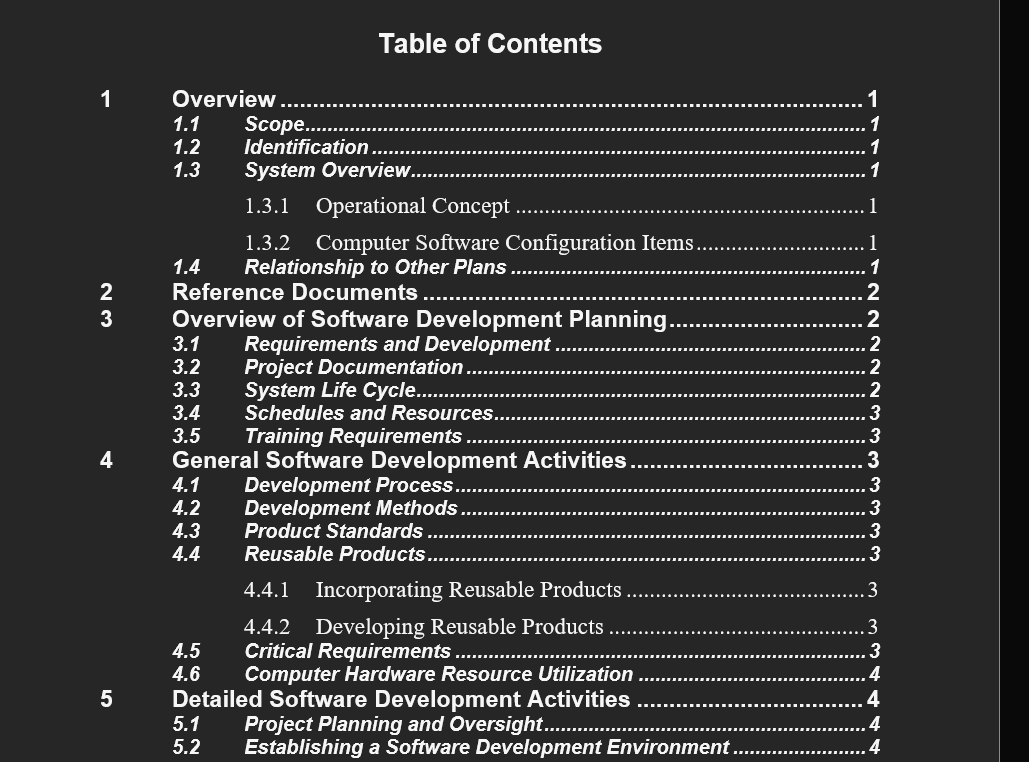
Next, we have a giant software project plan for the most advanced projects. From cost estimation, critical dates to delivery time, external dependencies, and acceptance criteria, there are various elements that you can use.
We do not recommend it for most purposes, as it is a rather significant time investment, and if you are doing something rather basic – it may be a tad overwhelming. But, in all other circumstances, keeping all the essential tasks and delivery dates secure can be pretty helpful. Nevertheless, it’s a book for your project, so proceed cautiously.
Software Project Plan Template #3
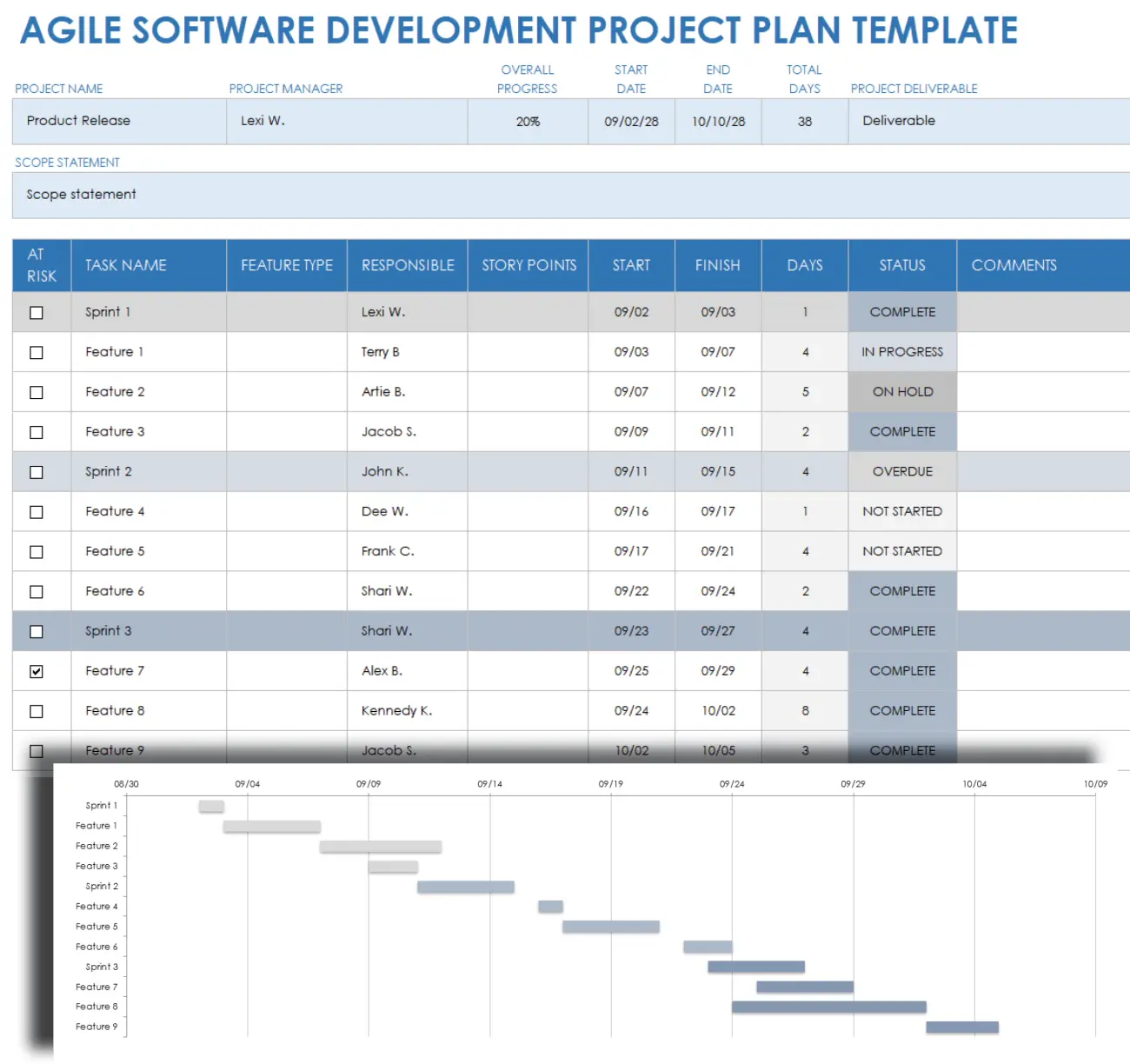
And finally, we have the agile software development project plan template between the two mentioned before. It can be great for multiple purposes, with some visually understandable graphics and a clear layout of tasks.
It’s a pretty popular template, and with all the interactive elements you can modify to your needs, it can become a pretty good tool for your development plans. Remember that all the formulas in the template are already there, so you don’t need to add anything new. You can just use the programmed ones.
Benefits of the Software Project Plan
So, now that we have a clear understanding of a software project plan and how you should go about your template choice, let’s go over some of the key benefits this tool can bring to the table. Of course, each software development process is different, so if you want to ensure the project success, you need to adjust those expectations to your goals.
Nevertheless, there are some common elements that we can point to to meet all the project needs.
Clear Objectives
The first thing we can point to is the clear project objectives. If you have an understandable goal that you are reaching for, it’s much easier to plan for each circumstance, limit the scope of your development process and create a roadmap for the stakeholders. It’s essential with big projects, like software development, when you need to coordinate with many different parties.
Resource Management
You also need to have good resource management, and a software project plan is excellent for that. With an outline, you can determine what resources you need for the project, who are the people you want to work with, and if there are some things you need to acquire to finish the project. It also helps you with avoiding missing deadlines and resource bottlenecks.
Risk Avoidance
The next thing we can point to is the risk avoidance. A good plan can help you avoid potential issues and create contingency plans for all of them. Avoiding risks is key to developing a successful project. It can steer you away from disastrous situations you may encounter on your path and optimize accordingly.
Project Management
The project plan is also just a good project management tool. You can monitor and control all the activities within your project, see what is in progress and what is yet to be achieved, and keep your hand on the pulse. The most significant impact is scheduling and resource allocation, as it can allow you to make data-driven decisions and coordinate between different company branches.
Communication
Speaking of coordination – good communication can never be underestimated. With a well-crafted plan, you can create communication channels that can help you coordinate different teams, exchange information, and have a more transparent and open relationship between different departments.
Delivery
Additionally, a well-crafted software project plan can help you see all the key milestones and dependencies that determine the delivery of a product. If you can track progress effectively, you can get even more resources allocated accordingly. Monitoring progress, identifying delays, and just overall – seeing the delivery of the project in action can help you optimize the process.
Stakeholders Expectations
Stakeholders' expectations should also be included in the project objectives, as it can be a good way of ensuring that everything is running smoothly and efficiently. Human resources are not easy to govern. But, if everyone is on the same page and can go back to what the project is all about by simply checking in the software project plan, it gets much easier to understand the roles and responsibilities of each stakeholder.
Flexibility
The software project plan also allows a lot of flexibility. You can change the project scope and see how it impacts the other elements, change the objectives, delivery timelines, etc. There are plenty of ways that you can modify your project without resorting to abandoning it altogether. It helps to minimize disruption and ensure the stability of the project.
Revision and Analysis
And finally – it’s a document that can be utilized for reviewing and analyzing different elements and strategies of the project. And – it can be used not only for the current project but also for all future ones. It’s a documented record of all the elements that went into the project, its creation, and modification so that it can be a valuable asset for the next project and essentially a knowledge transfer.
What to Include in a Software Project Plan?
So, now that we know what a software project plan is, its benefits, and the best templates on the market, let’s go over the critical components of every software project plan. The most important aspect is to adapt these elements to your current work and see if it fits your project.
Project Overview
The most essential element of the whole project. Here, you need to include all the most common information you have about the project, such as:
Title and description
Objectives and goals
Stakeholders
Project scope
Roles/Responsibilities
Here, you need to include all the stakeholders with their roles and responsibilities and their deadlines. Be sure to add the following:
Project team structure
Reporting lines
Communication channels
External stakeholders/their role and communication
Project Schedule
It’s essentially a timeline that you create to keep track of each task and avoid delivery delays. Consider including:
Start and end dates for each task/phase of the project
Milestones and deliverables
Dependencies (who needs to do what so that the other team member can work)
Critical paths
Budget
The budget part of the software project plan usually consists of all the elements you need to find financing for to complete the project. Here are something to consider:
Estimated costs
Allocation of financing and tracking
Contingency plans for overspending
Resources
Here, you must include all the resources necessary to finish the project. Those could be human resources or other. Be sure to include the following:
Resources necessary to complete the project
Allocation of resources
Roles and Responsibilities of Stakeholders
Risk Management
Next, we have the risk management section, which you need to utilize to see all the potential risks associated with the project. Be sure to include the following:
Ways of identifying project risks
Risk mitigation strategies
Contingency plans
People responsible for risk monitoring and prevention
Flexibility
The flexibility part concerns implementing procedures when something goes wrong and there is a need for some adjusting. The most common elements to include in this part are:
Change requests procedures
Change control team and their responsibilities
Change analysis/approval process
Key Performance Indicators
The key performance indicators part is where you put all the tracking/reporting elements of the project. Be sure to include the following:
Ways to track progress
Reporting mechanisms
Project status
Meetings schedule/reviews
Project Closure
And finally, we have the project closure to close the project effectively. Here, you should consider including the following:
Project completion and acceptance criteria
Handover plans
Documentation of project materials
Overview
Software Project Plan Tips
So, now that we know everything about the project plan, let’s see some tips that can help you craft your very own project plan! Remember that every project is different, and you may need to adjust those tips to your goals and the company's organizational structure. Without further ado, let’s get into it!
Divide the Project into Parts
One of the most important things to remember is that keeping an eye on the long-term goals is crucial. But everyday work happens on a much smaller scale. Divide your project into smaller parts – milestones that you can celebrate when they’re accomplished. It will help you not only keep track of everything but also give the stakeholders a much-needed breathing space.
Deadlines, Deadlines, Deadlines
…and some more deadlines. It’s one of the most problematic elements in the IT industry, as it usually takes a lot more time than previously thought to accomplish all the tasks. Be sure that your deadlines are realistic so that you can allocate the resources in an optimal way.
Assign Roles and Responsibilities
Define all the roles and responsibilities of the stakeholders clearly. Make sure that everyone knows their responsibilities, the company's dependencies and reporting structure. It will help you establish a safe and optimal working environment where everyone knows their duties and how to fulfil them. It can significantly improve the company’s functioning and the project’s success.
Think Ahead
The planning process is complex, so spend as much time on it as necessary. The most important aspect is to consider all the potential risks and see if anything develops during that time. It can save you a lot of money and potential headaches if done correctly.
Be a Good Communicator
Create channels of communication and protocols explaining how to use them. You want to communicate effectively with team members and stakeholders and explain them your project vision. Project managers sometimes are too busy with different aspects of the project that they tend to simplify their communication with one-worded emails. That can create a lot of confusion among the stakeholders.
Review and Analyze
And finally – review and analyze what is going on with the project and how you can improve it. Tracking the project’s progress can be challenging, especially if there are many phases/parts from entirely different company branches. Be sure to keep the documentation and assessment of the project archived, as it can help you in future projects.
Software Project Plan – Conclusion
Thanks for checking out our article on a software project plan! We hope that we were able to provide you with some good knowledge on this critical and exciting topic! As we have stated many times in this article, a well-drafted project plan can change the outcome of software development. Not only by helping you understand what you are trying to accomplish but also with risk assessment, assigning major stakeholders, budgeting and financing elements, and overall good project management.
By implementing the different strategies we have discussed, you can improve resource allocation and deadlines, keep communication between the stakeholders in check, and avoid potential issues. Especially those you could go into if you do not adequately prepare for the project. Software development projects help save time and understand all the resources required for this development. And, in the end, it’s a document that will help you in future endeavors and projects.
If you liked this article, check out our wide selection of texts on various topics, from gaming, to software and office-related stuff. And if you have any questions or suggestions about what are some of the issues we should cover in the future – be sure to let us know! That is it for today. Thanks for stopping by, and we will see you in the next one!















